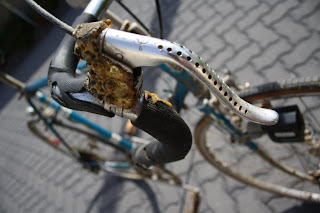I've written about the choices I've made in an earlier post, but quick recap.
Blast and Powder coat the frame. In an ideal world, I'd probably keep the original patina, but the patina is accompanied by surface corrosion. Blasting will kill the rust and powder coat, rather than paint provides a tough and durable finish. I wanted something that would pass for a racer, and the team bikes in the 70's were the classic white. So, it was an easy decision until I got to the powder coaters.
"So, which white?"
"There's only one isn't there?"
"No mate, we have 6"
"Sigh"
He showed me a collection of soft drink cans that he'd helpfully powder coated.
"Let's go with Arctic White"
A week later, it was back
A quick trip to the bike shop and the cups were pressed back in.
There are a bunch of methods of improvising a stem press, usually involving threaded rod and bronze cups.
All of the instructions suggest the need for to prevent getting them in on an angle, discretion in this case was the better part of valour.
I'd been hooked up with some new bearings, and got me some funky pink grease, so with the aid of another of my purchases, the new repair stand, resinstalling the forks was a pretty simple process.
Another decision concerned bar height. The Beast came equipped with quite a long quill stem, so I felt a bit of shortening was in order.
Five minutes fiddling about with the hacksaw and the stem was an inch shorter. I lengthened the slit up the back, and with a liberal application of grease to both the nut and the bottom of the stem shoved it back into the stearer tube.
Offered up the funky wheels and it started to look like a bike!
Now, to wait for some arrivals.
New Brooks b17 narrow in Brown leather from the UK
New bottle cage, brake blocks and cage mounts from the US
Replica Decals from NSW
Time for a hunt for the sundries needed to finish the rebuild.
New inner and outer cables, plus I discovered that Campag compatible shifter cables fit the Simplex Levers to perfection from BMCR!
Hoods for the DiaCompe non aero brakes, which I found hiding in the back of a larger LBS on the advice of the gang at Treadly.
A selection of stray nuts and bolts from all over
A roll of Fizzik Leather Bar Tape from Treadly, in a matching colour to the saddle. (I thought about this long and hard, and eventually went with the Velominati and their rules)
I still need to make a decision on pedals, so I have some sexy half clips from the US, a pair of block pedals
or some toe clips off my alloy roadie to choose from. For the moment, its the toe clips.



























